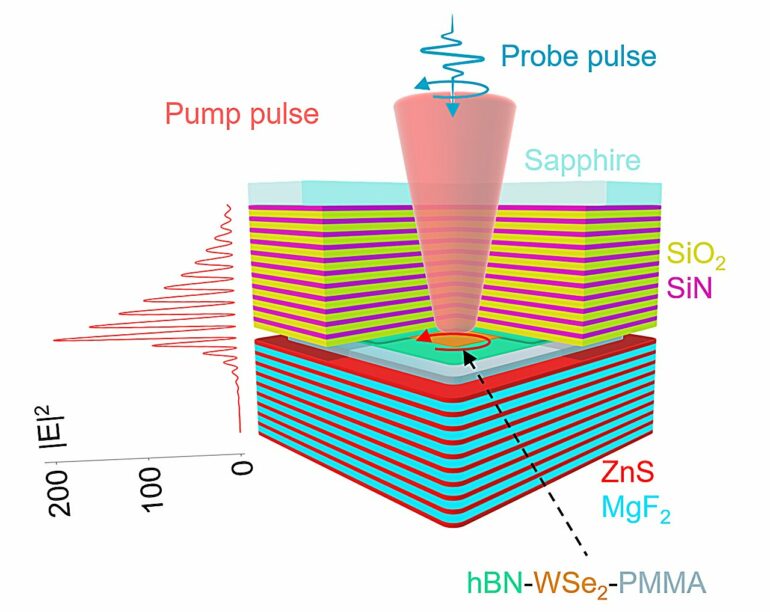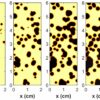Modern high-speed internet uses light to quickly and reliably transmit large amounts of data through fiber-optic cables, but currently, light signals hit a bottleneck when data processing is necessary. For that, they must convert into electrical signals for processing before further transmission.
A device called an all-optical switch could instead use light to control other light signals without the need for electrical conversion, saving both time and energy in fiber-optic communication.
A University of Michigan-led research team demonstrated an ultrafast all-optical switch by pulsing circularly polarized light, which twists like a helix, through an optical cavity lined with an ultrathin semiconductor. The study was recently published in Nature Communications.
The device could function as a standard optical switch, where turning a control laser on or off switches the signal beam of the same polarization, or as a type of logic gate called Exclusive OR (XOR) switch, which would produce an output signal when one light input twists clockwise and the other is counterclockwise but not when both inputs are the same.
“Because a switch is the most elementary building block of any information processing unit, an all-optical switch is the first step towards all optical computing or building optical neural networks,” said Lingxiao Zhou, a physics doctoral student at U-M and lead author of the study.
Optical computing’s low loss makes it more desirable than electronic computing.
“Extremely low power consumption is a key to optical computing’s success. The work done by our team addresses just this problem, using unusual two dimensional materials to switch data at very low energies per bit,” said Stephen Forrest, the Peter A. Franken Distinguished University Professor of Electrical Engineering at U-M and contributing author of the study.
To achieve this, the researchers pulsed a helical laser at regular intervals through an optical cavity—a set of mirrors that trap and bounce light back and forth multiple times—boosting the strength of the laser by two orders of magnitude.
When a one-molecule-thick layer of the semiconductor tungsten diselenide (WSe2) is embedded within the optical cavity, the strong, oscillating light enlarges the electronic bands of the available electrons in the semiconductor—a nonlinear optical effect known as the optical Stark effect. This means that when an electron jumps to a higher orbital, it absorbs more energy, and it emits more energy when it jumps down, known as blue shifting. This in turn modifies the signal light’s fluence, the amount of energy delivered or reflected per unit area.
In addition to modulating the signal light, the optical Stark effect produced a pseudo-magnetic field, which influences electronic bands similarly to those of a magnetic field. Its effective strength was 210 Tesla, far stronger than Earth’s strongest magnet with a strength of 100 Tesla. The enormously strong force is felt only by electrons whose spins are aligned with the helicity of the light, temporarily splitting the electronic bands of different spin orientations, directing the electrons in the aligned bands all in the same orientation.
The team could change the ordering of the electronic bands of different spins by changing the direction the light twists.
The brief uniform spin directionality of the electrons in different bands also breaks something called time reversal symmetry. Essentially, time reversal symmetry means that the physics underlying a process is the same forwards and backwards, implying conservation of energy.
While we typically can’t observe this in the macroscopic world due to the way energy dissipates through forces like friction, if you could take a video of electrons spinning, it would obey the laws of physics whether you played it forward or backward—the electron spinning one way would turn into an electron spinning the opposite way with the same energy. But in the pseudo-magnetic field, time reversal symmetry is broken because if rewound, the electron spinning in the opposite direction has a different energy—and the energy of different spins can be controlled through the laser.
“Our results open doors to a lot of new possibilities, both in fundamental science where controlling time reversal symmetry is a requirement for creating exotic states of matter and for technology, where leveraging such a huge magnetic field becomes possible,” said Hui Deng, a professor of physics and electrical and computer engineering at U-M and corresponding author of the study.
More information:
Lingxiao Zhou et al, Cavity Floquet engineering, Nature Communications (2024). DOI: 10.1038/s41467-024-52014-0
Provided by
University of Michigan College of Engineering
Citation:
All-optical switch device paves way for faster fiber-optic communication (2024, October 19)



